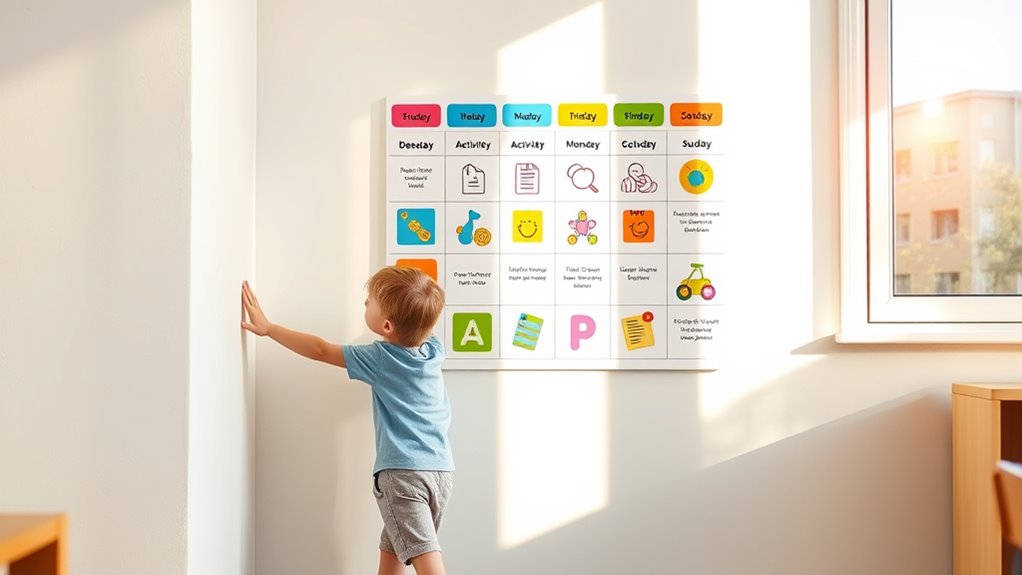Using visual schedules can markedly reduce friction in daily routines by providing clear signals and expectations, which helps you and others anticipate activities and shifts. They create a sense of security, decrease confusion, and promote cooperation by offering consistent visual cues. Placing and maintaining these schedules in accessible locations guarantees routines become familiar and stress-free. If you want to discover how to implement effective visual schedules, there’s more helpful information to explore below.
Key Takeaways
- Visual schedules provide clear, predictable cues that guide behavior and reduce misunderstandings, decreasing daily friction.
- Positioning visual cues in accessible areas ensures consistent reminders, easing transitions and minimizing stress.
- Using familiar pictures or symbols helps individuals anticipate upcoming activities, creating a smoother routine flow.
- Consistent routines reinforced by visual schedules foster independence, lowering the likelihood of disagreements or frustration.
- Maintaining simple, clear visual cues minimizes confusion, supporting a more harmonious and frictionless daily experience.

When daily routines become predictable through visual schedules, you can substantially reduce friction and stress. Visual cues serve as clear signals that guide behavior, helping you or your loved ones understand what’s next without confusion. This clarity creates a sense of security and control, especially for children or individuals who thrive on routine. The power of visual cues lies in their ability to communicate without words, making transitions smoother and reducing the need for repeated explanations. When everyone knows what to expect, frustration diminishes, and cooperation increases.
Visual schedules reduce stress by clearly guiding routines and easing transitions without confusion.
Routine consistency is the cornerstone of an effective visual schedule. When activities follow a predictable order, it’s easier to establish a steady rhythm in daily life. Consistent routines lessen the mental load of decision-making, freeing up energy for more important tasks. The visual aspect of these schedules reinforces routine consistency by providing tangible, easy-to-understand representations of daily activities. For example, a picture of breakfast, followed by a school bag, then a bus, visually confirms what’s happening next, reducing the chances of last-minute confusion. Over time, this predictability fosters independence, as individuals learn to anticipate and prepare for each step without constant reminders.
Creating a visual schedule involves selecting the right type of visual cues that resonate with your specific needs. Pictures, symbols, or written words can be used, depending on age and comprehension levels. When you incorporate these cues into your routine, it becomes a visual roadmap that anyone can follow. You’ll find that routines become less stressful because the visual cues act as prompts, guiding you through each task in a logical sequence. This not only streamlines daily activities but also minimizes disagreements or misunderstandings. As routines become more ingrained through consistency, the visual schedule becomes a trusted tool that supports independence and confidence.
To maximize the benefits, place the visual schedule in a prominent, easily accessible spot. This way, it serves as a constant reminder, reinforcing routine consistency. As habits form, you might find yourself relying less on the visual cues over time, but maintaining the schedule helps sustain structure. The key is to keep the visual cues simple and clear, avoiding clutter that might cause confusion. When routines are predictable and supported by effective visual cues, friction drops considerably. You and those around you experience smoother transitions, less stress, and a more harmonious daily flow. Ultimately, visual schedules empower you to manage daily life with greater ease and confidence.
Frequently Asked Questions
How Do Visual Schedules Differ Across Age Groups?
You’ll notice visual schedules differ across age groups because they align with developmental stages and cognitive differences. For young children, schedules feature simple pictures and minimal steps to match their limited attention spans and emerging literacy skills. Older kids and teens prefer more detailed visuals, including words and symbols, to support independence and complex routines. Adjusting the complexity helps each age group understand and follow their schedules effectively.
What Materials Are Best for Creating Durable Schedules?
Imagine customizing a visual schedule for a preschooler, using laminated cardstock for durability. You’ll want materials with high resilience, like laminated paper or plastic, to withstand daily handling. Durable materials ensure your schedule lasts and stays clear. You can also customize the schedule with velcro or magnets for easy updates. This way, you create a long-lasting, adaptable tool that meets the child’s evolving needs and maintains its quality over time.
How Can I Tailor Schedules for Diverse Learning Needs?
You can tailor schedules for diverse learning needs by implementing customization strategies like adjustable visuals, multimodal formats, and clear, simple language. Incorporate behavioral adaptations such as icons, color coding, or tactile elements to meet individual preferences. Regularly review and modify the schedule based on feedback and progress, ensuring it remains engaging and effective. This personalized approach helps students stay motivated and minimizes frustration, fostering a positive learning environment for everyone.
Are Digital Visual Schedules More Effective Than Paper Ones?
Digital visual schedules are often more effective than paper ones because they offer interactive features, easy updates, and customization, making them engaging for learners. You can quickly adapt digital schedules to individual needs, which enhances flexibility and motivation. While paper schedules are simple and portable, digital ones tend to provide a better effectiveness comparison due to their dynamic capabilities and ability to incorporate multimedia elements that support diverse learning styles.
How Do I Introduce Visual Schedules to Resistant Individuals?
Did you know that 75% of resistant individuals respond well to personalized approaches? To introduce visual schedules, use motivational strategies by explaining how they help reduce stress and increase independence. Start with simple, sensory-friendly visuals and involve the person in customization. Gradually incorporate the schedule into daily routines, making it feel like a helpful tool rather than a chore. This approach builds trust and makes acceptance easier.
Conclusion
By incorporating visual schedules, you make shifts smoother and daily routines less stressful. Isn’t it worth giving your loved ones the clarity they need to succeed? When you use visuals, you’re not just reducing friction—you’re building confidence and independence. Imagine the relief in their eyes when they know what’s coming next. So why not take that simple step today? After all, a little organization can make a world of difference in everyone’s life.









